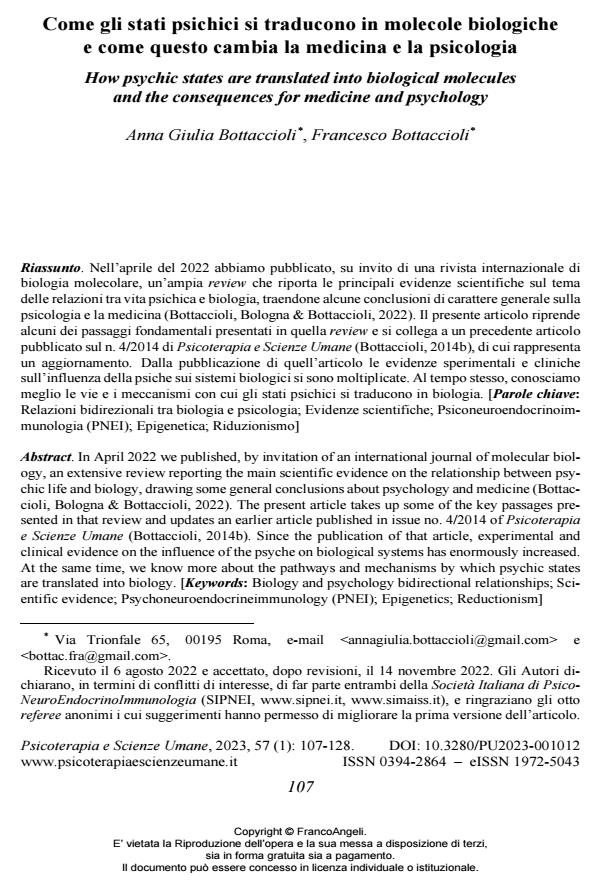Come gli stati psichici si traducono in molecole biologiche e come questo cambia la medicina e la psicologia
Titolo Rivista PSICOTERAPIA E SCIENZE UMANE
Autori/Curatori Anna Giulia Bottaccioli, Francesco Bottaccioli
Anno di pubblicazione 2023 Fascicolo 2023/1
Lingua Italiano Numero pagine 22 P. 107-128 Dimensione file 256 KB
DOI 10.3280/PU2023-001012
Il DOI è il codice a barre della proprietà intellettuale: per saperne di più
clicca qui
Qui sotto puoi vedere in anteprima la prima pagina di questo articolo.
Se questo articolo ti interessa, lo puoi acquistare (e scaricare in formato pdf) seguendo le facili indicazioni per acquistare il download credit. Acquista Download Credits per scaricare questo Articolo in formato PDF

FrancoAngeli è membro della Publishers International Linking Association, Inc (PILA)associazione indipendente e non profit per facilitare (attraverso i servizi tecnologici implementati da CrossRef.org) l’accesso degli studiosi ai contenuti digitali nelle pubblicazioni professionali e scientifiche
Nell’aprile del 2022 abbiamo pubblicato, su invito di una rivista internazionale di biologia molecolare, un’ampia review che riporta le principali evidenze scientifiche sul tema delle relazioni tra vita psichica e biologia, traendone alcune conclusioni di carattere generale sulla psicologia e la medicina (Bottaccioli, Bologna & Bottaccioli, 2022). Il presente articolo riprende alcuni dei passaggi fondamentali presentati in quella review e si collega a un precedente articolo pubblicato sul n. 4/2014 di Psicoterapia e Scienze Umane (Bottaccioli, 2014b), di cui rappresenta un aggiornamento. Dalla pubblicazione di quell’articolo le evidenze sperimentali e cliniche sull’influenza della psiche sui sistemi biologici si sono moltiplicate. Al tempo stesso, conosciamo meglio le vie e i meccanismi con cui gli stati psichici si traducono in biologia.
Parole chiave: Relazioni bidirezionali tra biologia e psicologia; Evidenze scientifiche; Psiconeuroendocrinoimmunologia (PNEI); Epigenetica; Riduzionismo
- La "mitodologia" della Legge 180 e la necessità di una rivoluzione culturale Franco Veltro, in PSICOTERAPIA E SCIENZE UMANE 2/2023 pp.285
DOI: 10.3280/PU2023-002006 - Franz Alexander, uno scienziato contemporaneo: un nuovo paradigma per la psicologia e la medicina Francesco Bottaccioli, Anna Giulia Bottaccioli, in PSICOTERAPIA E SCIENZE UMANE 2/2024 pp.251
DOI: 10.3280/PU2024-002003
Anna Giulia Bottaccioli, Francesco Bottaccioli, Come gli stati psichici si traducono in molecole biologiche e come questo cambia la medicina e la psicologia in "PSICOTERAPIA E SCIENZE UMANE" 1/2023, pp 107-128, DOI: 10.3280/PU2023-001012